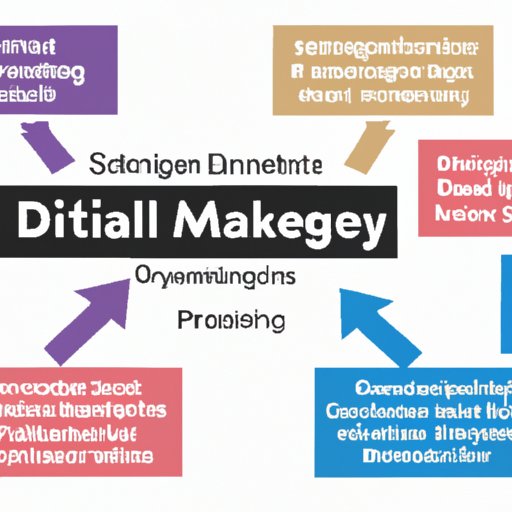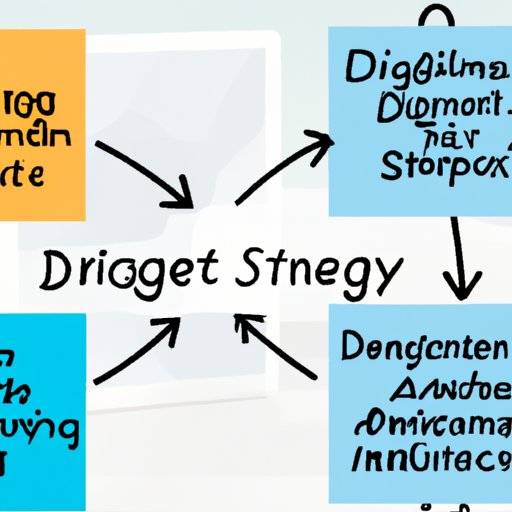Introduction
A digital strategy marketing plan is an important tool for any business that wishes to succeed in the digital age. It outlines the goals, objectives, and strategies to be used by a business in order to maximize its potential in the digital space. By developing a comprehensive digital strategy marketing plan, businesses can ensure that their efforts are focused on the right areas and that they are able to capitalize on the ever-changing digital landscape.
Benefits of Establishing a Digital Strategy Marketing Plan
Having a digital strategy marketing plan in place provides numerous benefits to businesses. A well-planned strategy helps businesses to define their goals and objectives and then create a plan to achieve them. It also helps to identify the target audience and analyze the market and competitors in order to develop effective strategies. Furthermore, it helps to track progress and measure success, which can then be used to refine and improve the strategy over time.

Necessary Steps to Develop a Digital Strategy Marketing Plan
Creating a successful digital strategy marketing plan requires a number of steps. The following outlines the necessary steps to develop a plan:
1. Define Goals and Objectives
The first step in creating a digital strategy marketing plan is to define the goals and objectives of the business. This includes identifying the short-term and long-term goals, such as increasing website traffic, generating leads, or improving customer loyalty. Goals should be specific, measurable, attainable, relevant, and time-bound (SMART) to ensure that they are achievable.
2. Research Your Target Audience
The next step is to research the target audience. This involves understanding who the business is trying to reach and what motivates them. Knowing the target audience will help to craft messages and determine the best channels to reach them.
3. Analyze the Market and Competitors
It is also important to understand the market and competitors. This involves researching the current landscape and analyzing the strengths and weaknesses of competitors. This will help to identify opportunities and threats and provide insights into how the business can differentiate itself from the competition.
4. Create a Strategic Plan
Once the goals and objectives, target audience, and market have been identified, the next step is to create a strategic plan. This plan should outline the strategies and tactics to be used to achieve the desired results. It should also include timelines, budgeting, and resources needed to implement the plan.
5. Implement Tactics
The next step is to implement the tactics outlined in the plan. This involves creating content, setting up social media accounts, optimizing websites for search engine optimization (SEO), and running paid advertising campaigns. It is important to ensure that all tactics align with the overall goals and objectives of the business.
6. Monitor Progress
Finally, it is important to monitor progress and measure success. This involves tracking key performance indicators (KPIs) and evaluating the effectiveness of the strategies and tactics. This will allow the business to refine and improve the plan over time.

Components of a Digital Strategy Marketing Plan
A digital strategy marketing plan typically consists of four main components: content, social media, search engine optimization (SEO), and paid advertising. Each component has its own set of strategies and tactics that must be implemented in order to achieve the desired results.
Content
Content is a key component of a digital strategy marketing plan. Content helps to engage customers, build trust, and establish the business as an authority in the industry. Content can take many forms, such as blog posts, videos, infographics, and ebooks. It is important to ensure that content is optimized for search engines and targeted towards the target audience.
Social Media
Social media is another important component of a digital strategy marketing plan. Social media allows businesses to connect with customers and build relationships. It is important to create a presence on the most popular platforms and regularly post engaging content. Additionally, it is important to monitor conversations and respond quickly to customer inquiries.
Search Engine Optimization (SEO)
Search engine optimization (SEO) is essential for any digital strategy marketing plan. SEO involves optimizing websites and content for search engines in order to increase visibility and drive organic traffic. This includes optimizing titles, descriptions, keywords, images, and other elements to improve rankings in search engine results pages (SERPs).
Paid Advertising
Paid advertising is another component of a digital strategy marketing plan. This involves running campaigns on various platforms, such as Google Ads, Facebook Ads, and Twitter Ads. Paid advertising can be used to increase brand awareness, generate leads, and drive sales. It is important to carefully monitor campaigns and adjust them as needed to ensure maximum efficiency.

Different Types of Digital Strategies and Tactics
There are a variety of digital strategies and tactics that can be used to achieve the desired results. These include content marketing, social media marketing, search engine optimization, email marketing, and paid advertising.
Content Marketing
Content marketing involves creating and distributing content, such as blog posts, videos, and infographics. This type of strategy is designed to engage customers, build trust, and establish the business as an authority in the industry.
Social Media Marketing
Social media marketing involves creating a presence on the most popular social media platforms and engaging with customers. This includes posting content, responding to inquiries, and monitoring conversations.
Search Engine Optimization
Search engine optimization (SEO) involves optimizing websites and content for search engines in order to increase visibility and drive organic traffic. This includes optimizing titles, descriptions, keywords, images, and other elements to improve rankings in SERPs.
Email Marketing
Email marketing involves sending emails to customers to promote products or services. This type of strategy can be used to build relationships, increase engagement, and generate leads.
Paid Advertising
Paid advertising involves running campaigns on various platforms, such as Google Ads, Facebook Ads, and Twitter Ads. This type of strategy can be used to increase brand awareness, generate leads, and drive sales.
Examples of Successful Digital Strategy Marketing Plans
There are numerous examples of successful digital strategy marketing plans. Here are three case studies of businesses that have achieved success through the use of digital strategies and tactics:
Case Study 1
A clothing company wanted to increase brand awareness and drive sales. To do this, they created a content marketing strategy and produced high-quality blog posts, videos, and infographics. They also ran paid advertising campaigns on Google Ads and Facebook Ads. As a result, the company saw a significant increase in website traffic and sales.
Case Study 2
A restaurant wanted to increase customer loyalty and generate more repeat customers. To do this, they created a social media marketing strategy and established a presence on the most popular platforms. They also ran email campaigns to keep customers informed about new menu items and special offers. As a result, the restaurant saw an increase in customer loyalty and repeat customers.
Case Study 3
An online retailer wanted to increase website traffic and generate more leads. To do this, they created a search engine optimization (SEO) strategy and optimized their website for search engines. They also ran paid advertising campaigns on Google Ads and Twitter Ads. As a result, the online retailer saw a significant increase in website traffic and leads.
Conclusion
A digital strategy marketing plan is an essential tool for any business that wants to succeed in the digital age. It outlines the goals, objectives, and strategies to be used by a business in order to maximize its potential in the digital space. Creating a successful digital strategy marketing plan requires a number of steps, including defining goals and objectives, researching the target audience, analyzing the market and competitors, creating a strategic plan, implementing tactics, and monitoring progress. It also involves four main components: content, social media, search engine optimization (SEO), and paid advertising. There are a variety of digital strategies and tactics that can be used to achieve the desired results, such as content marketing, social media marketing, search engine optimization, email marketing, and paid advertising. Finally, there are numerous examples of successful digital strategy marketing plans, such as those outlined in the case studies above.
(Note: Is this article not meeting your expectations? Do you have knowledge or insights to share? Unlock new opportunities and expand your reach by joining our authors team. Click Registration to join us and share your expertise with our readers.)
